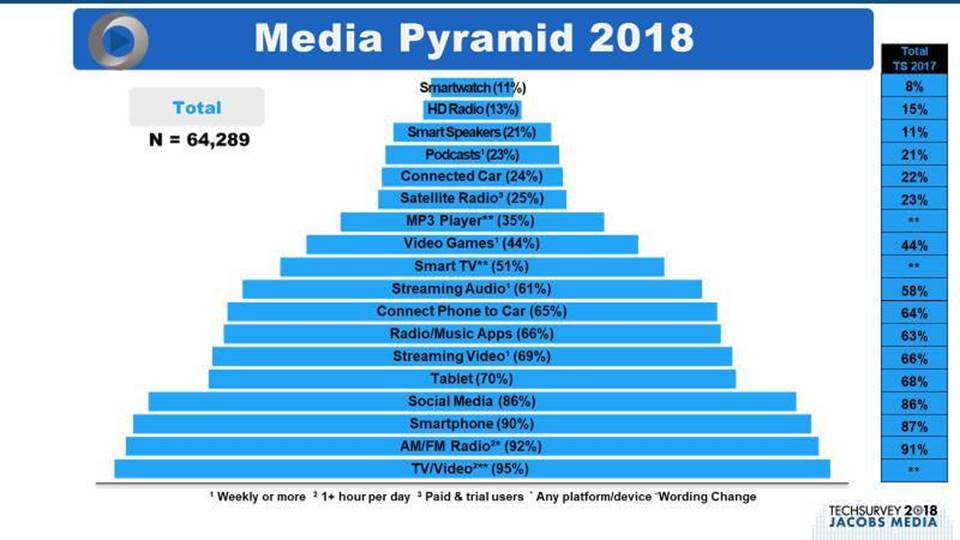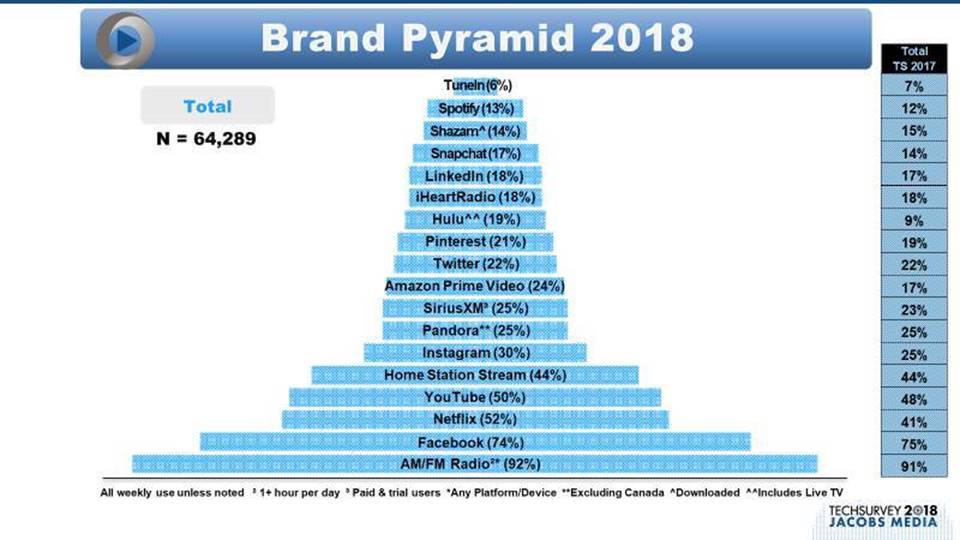567 stations | 64,289 respondents
14 radio formats | 5 generations
Free webinar scheduled for Thursday, May 24th at 2pm ET
Bingham Farms, MI — In Jacobs Media’s Techsurvey 2018 – our 14th annual online mega-survey of radio listeners – a big story continues to emerge with the continued changes taking place in radio’s traditional listening locations – the home, the car, and the workplace. From Pandora, Spotify, and SiriusXM satellite radio, to the emergence of Amazon Alexa and smart speakers, the traditional patterns of media usage and radio listening are rapidly changing.
The media habits of 14 format core audiences, along with five generations, are examined in this largest ever survey of radio listeners. From Boomers to Millennials, different patterns of consumption are emerging, providing radio broadcasters with the tools they need to map out game plans and strategies.
The survey was conducted in early 2018 between January 16 and February 26. Stakeholder stations participated in a webinar on April 30, and the results of the study will be released over the next few months.
A free webinar — “10 Key Takeaways from Techsurvey 2018” — is scheduled for Thursday, May 24th at 2pm ET. Registration info is here.
As Jacobs Media President Fred Jacobs points out, “We are continuing to see increasing digital platform usage for all forms of audio, particularly the emergence of Amazon’s Alexa, Google Home and the rise of smart speakers, whose ownership has nearly doubled in just one year.”
Techsurvey 2018 provides two different “pyramids” for stakeholder stations. The “Media Pyramid” contains broad categories, including smartphone and tablet ownership, audio and video streaming, as well as voice-command smart speakers like the Amazon Echo.
The “Brand Pyramid” continues to provide fascinating usage information about big brands that include Netflix, Instagram, Pandora, and Hulu.
Paul Jacobs, Jacobs Media General Manager, continues, “In addition to the boom in smart speaker penetration, many forms of digital media, including podcasting, satellite radio, streaming audio and streaming video all show increases in the number of regular users year-over-year.”
More than nine in ten respondents spend at least one hour a day with radio and/or television, the foundation of this pyramid.
This year’s Media Pyramid is below:

Other highlights include:
- Fewer are using in-home radios. Those with regular radios they use in the home now sits at 83% and is markedly lower among Millennials (68%). Devices like smart speakers (Amazon Alexa, Google Home, etc.) and smart TVs are increasingly replacing regular radio usage in the home.
- Smart speaker penetration explodes. In the span of just over two years since their availability, smart speakers are now owned by more than one in five (21%) respondents, up from 11% just one year ago. And for many owners of these devices, their use of music and spoken word programming from broadcast radio stations is increasing.
- AM/FM radio, it’s free & easy. Consumers continue to love broadcast radio for the music, personalities, and emotional drivers, such as companionship and mood elevation. However, nearly seven in ten (69%) say the fact it is easiest to listen to in the car is a main reason they enjoy listening to the radio (the most mentioned response among the choices presented), while six in ten (60%) say a main reason for listening is that it’s a free service.
- Mobile devices are in more hands than ever. Smartphone ownership increases to nine in ten respondents (90%), while tablet ownership now reaches 70%.
- Radio’s digital platforms are rapidly growing. While 70% of consumption to the average station in TS 2018 takes place on “regular radios,” 27% of usage is now occurring via digital platforms — computer streams, mobile apps, smart speakers and podcasts — up sharply from 22% this time last year. Among Millennials, 31% of their listening is via digital platforms (vs. 65% on a regular radio).
- AM/FM radio dominates at-work audio consumption. More than half of those who say they listen to any audio while working report frequently listening to AM/FM on a regular radio in the workplace (54%). An additional 23% listen to AM/FM streams on a computer/laptop, while 21% say they stream AM/FM radio stations on a mobile device such as a smartphone or tablet. To a lesser degree, frequent workplace listening is to personal music (23%), Pandora (17%), SiriusXM (11%), and Spotify (10%).
- Weekly podcast listening approaches one in four. Listening to podcasts on a weekly basis or more often is now 23%, up slightly from 21% one year ago. About three-fourths of regular podcast users (74%) listen on a smartphone, followed by fewer than half on a desktop/laptop computer (44%). Music (42%) and radio shows that previously aired (39%) are the top podcast categories regularly listened to among weekly podcast users.
This year’s Brand Pyramid provides data points that help broadcasters get more granular with their audiences, identifying the key media brands they use. For each of the brands and platforms, this pyramid shows weekly usage (with the exception of AM/FM radio which is one hour/day or more, SiriusXM which is based on subscribership/free trial, and Shazam which is based on those downloading the app).

Here are some of the highlights from this year’s Brand Pyramid:
- Facebook remains the dominant social media platform. Nearly three-fourths (74%) use Facebook weekly or more. Both Instagram and Snapchat, while firmly behind Facebook in overall social media usage, show healthy growth.
- Streaming video brands see large gains. More than half now use Netflix on a weekly basis (52%), up sharply in the past year (41% in last year’s study). Amazon Prime Video and Hulu also show large spikes in weekly usage, at 24% and 19% respectively.
- Streaming audio brands are mostly flat. One-fourth (25%) listen to Pandora on a weekly basis, flat in the last year after having seen a drop in weekly usage the previous two years. iHeartRadio remains flat at 18% year to year, while Spotify is only up incrementally (now 13% vs. 12% one year ago).
Both the Media and Brand pyramids are available by format, gender, and generation, making them useful tools in better understanding how radio listeners are expanding their horizons.
This year’s survey covers key areas of interest to all media brands, including actionable information about connected and autonomous cars, social media usage, mobile devices and apps, audio and video streaming, and other key topics.
- Finding Innovation, Momentum, and Innovation at CES with Fred and Paul Jacobs - January 1, 2024
- Press Release: During the Pandemic, Activities Consumers Are Ready To Do - May 27, 2020
- Digital Listening Continues to Impact Key Radio Listening Locations – the Home, the Car, & the Workplace - May 16, 2018




Leave a Reply